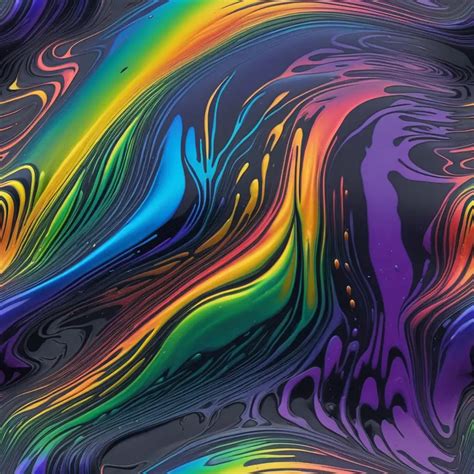Introduction

Oil slick colors, with their mesmerizing iridescence and enigmatic allure, have captured the imagination of artists, designers, and fashion enthusiasts alike. These colors, often characterized by a vibrant spectrum of greens, blues, purples, and golds, evoke a sense of ethereal beauty that has inspired countless creations.
Historical Significance
The phenomenon of oil slick colors has been known for centuries. As early as the 16th century, artists such as Jan van Eyck utilized glazing techniques to replicate the iridescent effects of oil slicks. In the 19th century, the Impressionists, particularly Claude Monet, were drawn to the changing colors of the Seine River, capturing the oil slicks’ play of light in their paintings.
Scientific Basis
Oil slick colors arise due to the interference of light with a thin film of oil on the surface of water. As light passes through the film, it refracts, reflects, and diffracts, giving rise to a spectrum of colors. The thickness of the film, the angle of incidence of light, and the presence of multiple layers affect the resulting color pattern.
Art and Design Applications
- Oil slick paintings: Artists use oil-based paints, resins, or other mediums to create paintings that mimic the iridescent effects of oil slicks.
- Jewelry design: Oil slick colors are incorporated into jewelry pieces, such as earrings, necklaces, and pendants, creating eye-catching and ethereal accessories.
- Fashion and textiles: Oil slick colors have become a trendy motif in fashion. Designers utilize fabrics with oil slick patterns, embellishments, or prints to add visual intrigue to garments and accessories.
- Product design: From phone cases to home décor, oil slick colors find applications in various product designs, enhancing the aesthetic appeal of everyday objects.
Industrial Innovations
Beyond art and design, oil slick colors have inspired innovative applications in different industries:
- Solar cells: Researchers have developed oil slick-inspired solar cells that mimic the iridescence of oil slicks to enhance light absorption and energy conversion efficiency.
- Anti-counterfeiting: Oil slick colors can be incorporated into banknotes and other security documents as a tamper-proof feature. The iridescent patterns are difficult to replicate, making counterfeiting more challenging.
- Oil spill detection: Oil slick colors can aid in detecting and monitoring oil spills in water bodies. By analyzing the spectral characteristics of oil slicks, scientists can estimate the extent and thickness of the spill.
Statistics and Economic Impact
- The global market for oil slick color products is estimated to grow from $2.7 billion in 2021 to $4.1 billion by 2028.
- According to a study by the Gemological Institute of America, jewelry featuring oil slick gemstones has increased in popularity by 35% in recent years.
- Oil slick-inspired solar cells have the potential to significantly increase solar energy production, contributing to the transition to renewable energy sources.
Inducing “Iridescology”: A Novel Concept for Creative Applications
We introduce a new term, “iridescology,” to describe the study and utilization of oil slick colors. Iridescology encompasses the observation, analysis, and application of iridescent phenomena inspired by oil slicks. This concept can inspire innovative designs and applications in various fields, such as:
- Architecture and lighting: Iridescent surfaces can create visually stunning facades, interiors, and light fixtures that play with color and light.
- Biomimicry: Oil slick-inspired materials and structures can be explored for their potential in biological applications, such as anti-fouling coatings and sensors.
- Artificial intelligence (AI): AI algorithms can be trained to analyze and predict oil slick color patterns, enabling the identification of oil spills and the optimization of solar cell designs.
Tables
- Table 1: Oil Slick Color Applications in Different Industries
| Industry | Application |
|---|---|
| Art | Oil slick paintings, jewelry design |
| Fashion | Oil slick fabrics, garments, accessories |
| Product design | Phone cases, home décor, electronic devices |
| Solar energy | Oil slick-inspired solar cells |
| Anti-counterfeiting | Security documents, banknotes |
| Oil spill detection | Monitoring and detection of oil spills in water bodies |
- Table 2: Economic Impact of Oil Slick Colors
| Year | Market Value |
|---|---|
| 2021 | $2.7 billion |
| 2028 (Projected) | $4.1 billion |
- Table 3: Colors Commonly Associated with Oil Slicks
| Color | Wavelength Range |
|---|---|
| Red | 620-750 nm |
| Orange | 590-620 nm |
| Yellow | 570-590 nm |
| Green | 520-570 nm |
| Blue | 450-520 nm |
| Purple | 430-450 nm |
- Table 4: Tips for Incorporating Oil Slick Colors into Designs
| Tip | Description |
|---|---|
| Layer different materials | Combine transparent and opaque materials to create depth and complexity. |
| Use contrasting colors | Pair iridescent surfaces with contrasting colors to enhance their visual impact. |
| Experiment with light | Play with different light sources and angles to observe how they affect the color patterns. |
| Explore geometric shapes | Use geometric patterns to organize and emphasize the oil slick colors. |
| Consider scale | Scale up or down the size of the iridescent patterns to create different visual effects. |
Conclusion
Oil slick colors, with their otherworldly beauty and versatility, continue to inspire artists, designers, and innovators worldwide. From breathtaking paintings to cutting-edge solar technologies, these colors transcend the boundaries of traditional art and find applications in various disciplines. As iridescology’s influence grows, we can expect to witness even more astounding and innovative uses of these mesmerizing hues in the years to come.
